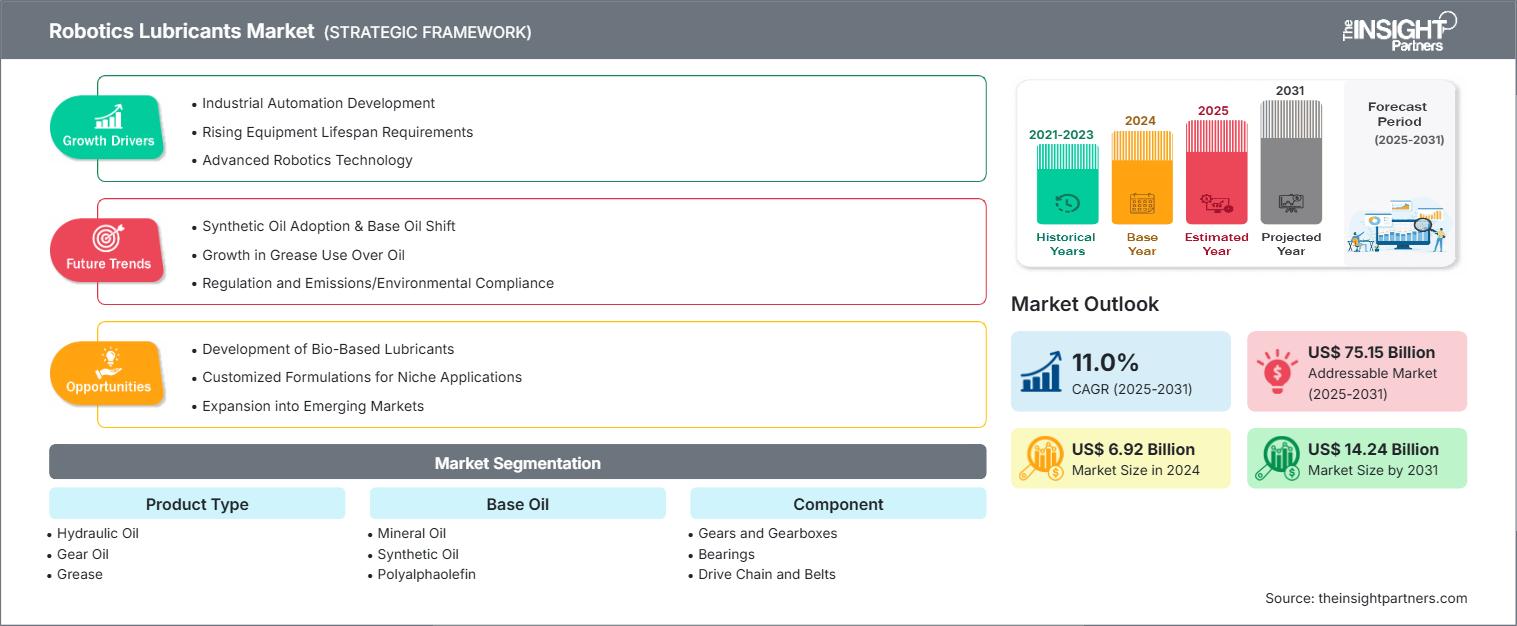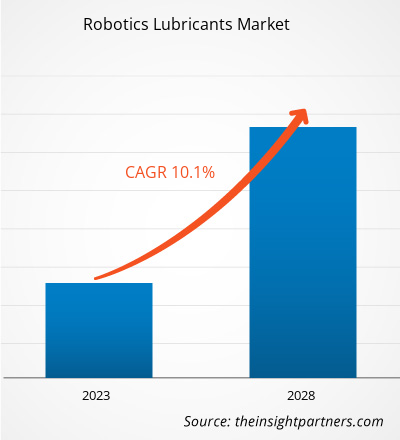로봇 윤활제 시장 규모는 2024년 69억 2천만 달러에서 2031년 142억 4천만 달러로 성장할 것으로 예상됩니다. 이 시장은 2025년부터 2031년까지 11.0%의 CAGR을 기록할 것으로 예상됩니다.
로봇 윤활유 시장 분석
로봇 윤활제 산업은 제조, 물류, 의료 및 서비스 산업에서 자동화 사용이 증가함에 따라 성장하고 있습니다. 효율성, 인건비, 생산 일관성을 향상시키기 위해 여러 분야에서 로봇 공학의 사용이 증가함에 따라 고성능 윤활제에 대한 수요도 증가하고 있습니다. 로봇 시스템의 정밀성과 신뢰성은 특히 연속 또는 고속 모드에서 적절하게 작동하고 부품의 마모를 방지하기 위해 특정 윤활을 필요로 합니다. 또한, 협동 로봇 및 모바일 자동화와 같은 고급 로봇 기술의 발전은 정의된 윤활 요건을 가진 새로운 응용 분야를 제공하고 있습니다. 또한, 기업들이 모니터링 시스템과 통합될 수 있는 특수 윤활제에 관심을 보이면서 스마트 팩토리에 대한 투자 증가도 시장 성장에 기여하고 있습니다. 환경 및 안전 관련 법규 또한 더욱 친환경적이고 지속 가능한 윤활제 솔루션 개발을 촉진하고 있으며, 이는 시장 확대를 더욱 촉진하고 있습니다.
로봇 윤활제 시장 개요
로봇 윤활제는 기어, 조인트, 액추에이터, 베어링과 같은 로봇 부품의 마찰, 마모, 열을 최소화하도록 설계된 특수 오일 또는 그리스입니다. 이러한 윤활제는 특히 24시간 내내 작동하거나 기계가 기계적 압력을 받을 때 로봇 시스템의 원활하고 정확한 작동을 보장하는 데 중요한 역할을 합니다. 일반 윤활제와 달리, 로봇 윤활제는 고온, 가변 속도, 그리고 무독성, 저잔류물 또는 클린룸 친화적인 윤활제가 필요한 환경에서도 안정적으로 작동하도록 설계되었습니다. 로봇 윤활제는 로봇 부품의 수명 주기를 늘리고, 유지보수 요구 사항을 줄이며, 시간이 지나도 동일한 성능을 유지하는 데 도움이 됩니다. 자동화에 대한 수요가 증가함에 따라, 로봇 윤활제는 산업, 상업 및 서비스 부문의 가동 시간 최적화, 정확성 및 장비 보호를 보장하는 데 필수적입니다.
이 보고서의 일부 또는 국가 수준 분석, Excel 데이터 팩을 포함하여 모든 보고서에 대한 사용자 정의를 무료로 받을 수 있으며, 스타트업 및 대학을 위한 훌륭한 혜택과 할인도 이용할 수 있습니다.
로봇 윤활제 시장: 전략적 통찰력

-
이 보고서의 주요 시장 동향을 알아보세요.이 무료 샘플에는 시장 동향부터 추정치 및 예측까지 다양한 데이터 분석이 포함됩니다.
로봇 윤활유 시장 동인 및 기회
시장 동인:
-
산업 자동화 개발:
다양한 산업 분야에서 산업 자동화 개발을 지원하는 호의적인 정부 이니셔티브.
-
증가하는 장비 수명 요구 사항:
장비의 수명 연장에 대한 수요가 증가함에 따라 고성능 윤활유에 대한 수요도 증가하게 되었습니다.
-
첨단 로봇 기술:
제조 자동화를 목표로 하는 첨단 로봇 기술의 개발로 인해 로봇 윤활유에 대한 수요가 증가하고 있습니다.
-
깨끗하고 통제된 환경의 성장:
식품 가공, 제약, 의료 제조 분야의 수요가 증가함에 따라 클린룸에 적합하고 엄격한 안전 및 위생 기준을 충족하는 무독성 윤활제를 사용해야 하는 수요가 증가하고 있습니다.
시장 기회:
-
생물 기반 윤활제 개발:
환경에 대한 우려가 커지면서 생물 기반 윤활제에 대한 기회가 생겨나고 있습니다. -
틈새 시장 응용 프로그램을 위한 맞춤형 제형:
안전, 낮은 잔류물, 특수 성능이 가장 중요한 협업 로봇, 서비스 로봇, AGV에 대한 적용 분야별 윤활제에 대한 수요가 증가하고 있습니다. -
신흥 시장으로의 확장:
남미, 중미, 동남아시아 등 신흥 시장에서 스마트 제조 추세가 확산됨에 따라 로봇 윤활유에 대한 수요도 증가할 것으로 예상됩니다.
로봇 윤활유 시장 보고서 세분화 분석
로봇 윤활제 시장은 시장 성장 잠재력과 최신 동향을 폭넓게 파악할 수 있도록 세분화되었습니다. 대부분의 업계 보고서에서 사용되는 표준 세분화 방식은 다음과 같습니다.
제품 유형별:
-
유압 오일:
자동화 시스템에서 정밀한 제어 동작을 위한 로봇 윤활유에 사용됩니다. -
기어 오일:
기어 오일은 극한 상황에서 마찰을 줄이고 성능을 향상시키는 데 사용됩니다. -
유지:
로봇 관절과 베어링에 적용되는 반고체 윤활제로, 윤활제가 오랫동안 지속되어야 하며 유지 보수가 거의 필요하지 않습니다. -
건식 윤활제:
이는 로봇 구성 요소의 관절과 베어링에서 마찰과 마모를 줄이는 데 도움이 됩니다. -
고체 윤활제:
극한의 조건과 고온에서 로봇 시스템의 마찰을 줄이는 데 사용됩니다.
베이스 오일 기준:
-
미네랄 오일:
석유 기반의 기유로, 일반 용도 로봇 응용 분야에서 기본적인 성능을 제공하는 표준 윤활제 제형에 사용됩니다. -
합성 오일:
이러한 소재는 열 조건에서 매우 안정적이며, 산화에 강하고, 고성능 로봇 시스템의 수명을 향상시킵니다. -
기타:
여기에는 마찰을 줄여주는 생물 기반, 에스테르 기반 또는 특수 유체가 포함됩니다.
구성 요소별:
-
기어 및 기어박스:
윤활유를 기어와 변속기에 바르면 과열을 방지하여 마찰과 마모를 줄여줍니다. -
문장:
윤활제는 베어링의 저항과 과열을 줄여 정밀한 움직임을 보장하는 데 사용됩니다. -
구동 체인 및 벨트:
윤활제는 동적 로봇 시스템에서 움직이는 체인과 벨트의 부식, 마모, 정렬 불량을 방지합니다. -
리듀서:
윤활제는 높은 하중 지지 용량이 필요한 속도 감소 요소에 적용됩니다. -
기타:
여기에는 특정 윤활 솔루션이 필요한 액추에이터, 씰 또는 선형 가이드가 포함됩니다.
로봇 유형별:
-
산업용 로봇:
고성능 윤활제를 사용하면 제조 및 조립 시설에서 지속적이고 고속 작업이 지원됩니다. -
협동 로봇:
인간과 로봇이 공유하는 작업 공간에서 안전하고 기계적 정밀도를 제공하는 깨끗하고 생물학적 기반의 윤활제가 필요합니다. -
서비스 로봇:
소음이 적고 잔여물이 거의 남지 않으며 공공 또는 상업 환경에서 안정적으로 작동하는 특수 윤활제를 사용하세요. -
인간형 로봇:
복잡하고 인간과 유사한 움직임과 다중 관절 관절을 구현하려면 가볍고 유연한 윤활 솔루션이 필요합니다. -
기타:
의료, 수중, 방어용 로봇 등 틈새 로봇도 포함되며, 각 로봇은 특정 환경에서 작동하기 위해 특정 윤활이 필요합니다.
최종 사용 산업별:
-
자동차:
고속 조립 및 용접 로봇에 로봇 윤활유를 적용하여 정밀성, 신뢰성, 긴 서비스 수명을 제공합니다. -
음식 및 음료:
위생적이고 오염에 민감한 구역에서 로봇을 작동하려면 식품 등급의 무독성 윤활제가 필요합니다. -
의료 및 건강 관리:
클린룸에 적합하고 배출이 적은 수술 로봇과 자동화 의료 장비 윤활제가 필요합니다. -
전기 및 전자:
정전 및 먼지에 민감한 환경에서 민감한 부품을 다루는 클린룸 로봇에 특수 윤활제를 사용합니다. -
궤조:
이 산업에서는 극한의 작업 환경에서 연마재를 절단, 용접, 단조하고 취급하는 로봇에 고성능 윤활제를 사용합니다. -
기타:
여기에는 자동화를 활용하는 물류, 항공우주, 제약 분야와 같은 산업이 포함됩니다.
지리별:
- 북아메리카
- 유럽
- 아시아 태평양
- 남미와 중미
- 중동 및 아프리카
아시아 태평양 지역의 로봇 윤활제 시장은 가장 빠르게 성장할 것으로 예상됩니다. 이 지역 최종 사용 산업의 수요 증가가 이러한 성장세를 뒷받침합니다.
로봇 윤활유 시장 지역별 통찰력
The Insight Partners의 분석가들은 예측 기간 동안 로봇 윤활제 시장에 영향을 미치는 지역별 동향과 요인을 면밀히 분석했습니다. 이 섹션에서는 북미, 유럽, 아시아 태평양, 중동 및 아프리카, 그리고 중남미 지역의 로봇 윤활제 시장 부문과 지역별 현황도 살펴봅니다.
로봇 윤활유 시장 보고서 범위
| 보고서 속성 | 세부 |
|---|---|
| 2024년 시장 규모 | 69억 2천만 달러 |
| 2031년까지 시장 규모 | 142억 4천만 달러 |
| 글로벌 CAGR(2025~2031년) | 11.0% |
| 역사적 데이터 | 2021-2023 |
| 예측 기간 | 2025-2031 |
| 다루는 세그먼트 |
제품 유형별
|
| 포함된 지역 및 국가 |
북아메리카
|
| 시장 선도 기업 및 주요 회사 프로필 |
|
로봇 윤활유 시장 참여자 밀도: 비즈니스 역학에 미치는 영향 이해
로봇 윤활제 시장은 소비자 선호도 변화, 기술 발전, 그리고 제품 이점에 대한 인식 제고 등의 요인으로 인한 최종 사용자 수요 증가에 힘입어 빠르게 성장하고 있습니다. 수요가 증가함에 따라 기업들은 제품 라인업을 확장하고, 소비자 니즈를 충족하기 위한 혁신을 추진하며, 새로운 트렌드를 적극 활용하고 있으며, 이는 시장 성장을 더욱 가속화하고 있습니다.

- 로봇 윤활제 시장의 주요 기업 개요를 확인하세요
지역별 로봇 윤활유 시장 점유율 분석
아시아 태평양 지역은 향후 몇 년 동안 가장 빠른 성장세를 보일 것으로 예상됩니다. 중남미, 중동, 아프리카의 신흥 시장 또한 로봇 윤활유 공급업체들이 확장할 수 있는 많은 미개척 기회를 보유하고 있습니다.
로봇 윤활제 시장은 지역마다 성장세가 다릅니다. 스마트 제조에 대한 수요는 지속적으로 증가하여, 변화하는 소비자 환경에서 로봇 윤활제는 전 세계적으로 선호되는 품목으로 자리매김하고 있습니다. 아래는 지역별 시장 점유율 및 동향을 요약한 것입니다.
1. 북미
-
시장 점유율:
글로벌 시장의 상당 부분을 차지합니다 -
주요 동인:
- 다양한 산업 분야에서 스마트 제조 도입이 증가하고 있습니다.
- 예측적 유지관리와 성능 최적화에 중점을 둡니다.
-
트렌드:
데이터 기반 유지 관리 전략을 지원하기 위해 상태 모니터링 기술이 통합된 스마트 윤활제에 대한 수요가 증가하고 있습니다.
2. 유럽
-
시장 점유율:
상당한 시장 점유율을 보유하고 있습니다 -
주요 동인:
- 엄격한 환경 규제로 인해 친환경적이고 배출이 적은 윤활유 사용이 장려됩니다.
- 첨단 제조 인프라.
-
트렌드:
EU의 지속 가능성 목표에 따라 생물 기반 및 생분해성 윤활제로 전환합니다.
3. 아시아 태평양
-
시장 점유율:
시장을 지배하고 있으며 매년 시장 점유율이 증가하면서 가장 빠르게 성장하는 지역이기도 합니다. -
주요 동인:
- 대규모 산업 제조.
- 이 지역 전역에서 정부 주도의 이니셔티브가 진행됩니다.
-
트렌드:
국내 로봇 생산이 증가함에 따라 지역별 윤활유에 대한 수요가 증가하고 있습니다.
4. 중동 및 아프리카
-
시장 점유율:
상당한 진전을 이루는 성장하는 시장 -
주요 동인:
- 산업 다각화에 대한 투자 확대.
- 인프라 개발이 증가하고 있습니다.
-
트렌드:
산업 전반에서 제조업의 자동화가 확대되고 있습니다.
5. 남미 및 중미
-
시장 점유율:
작지만 빠르게 성장하고 있습니다 -
주요 동인:
- 자동차 조립 및 식품 가공 산업의 확장.
- 비용 중심 자동화 도입.
-
트렌드:
지속 가능하고 유지 관리가 쉬운 윤활제 제품에 대한 관심이 높아지고 있습니다.
로봇 윤활유 시장 참여자 밀도: 비즈니스 역학에 미치는 영향 이해
높은 시장 밀도와 경쟁
Petrelplus Inc., Shell Plc., Fuchs SE, BP Plc., TotalEnergies SE, Idemitsu Kosan Co Ltd와 같은 기존 업체가 많아 경쟁이 치열해지면서 여러 지역의 경쟁 환경이 더욱 복잡해졌습니다.
이러한 높은 수준의 경쟁으로 인해 기업은 다음과 같은 서비스를 제공하여 두각을 나타내야 합니다.
- 혁신적인 제품 제공
- 지속 가능하고 윤리적인 조달
- 경쟁력 있는 가격 모델
- 강력한 고객 지원 및 쉬운 통합
기회와 전략적 움직임
- 시장에서 두각을 나타내기 위해 연구 개발 활동에 집중합니다.
- 부가가치가 있는 제과 브랜드 인수를 통해 글로벌 영향력과 역량을 확대합니다.
- 여러 가지 제빵류와 과자류를 출시하여 제품 포트폴리오를 확대합니다.
로봇 윤활제 시장에서 활동하는 주요 기업은 다음과 같습니다.
- 페트렐플러스 주식회사
- 쉘 주식회사
- 푸크스 SE
- BP 주식회사
- 토탈에너지 SE
- 이데미츠코산(주)
- 매트릭스 스페셜티 윤활제 B
- 케미테크닉 GmbH
- 퀘이커 케미컬 코퍼레이션(퀘이커 호튼)
- 쉐브론 주식회사
면책 조항: 위에 나열된 회사는 특정 순서에 따라 순위가 매겨지지 않았습니다.
연구 과정에서 분석된 다른 회사:
- 시트고 석유 주식회사
- 케무어스 주식회사
- 발볼린 주식회사
- 밀러-스티븐슨 주식회사
- 페트롤리암 나시오날 Bhd
- 캐스트롤 리미티드
- 몰리그래프
- 파워맥스 루브 인디아
- 나브테스코 프리시전 유럽 GmbH
- 그리스디비전
로봇 윤활제 시장 뉴스 및 최근 동향
-
METALUBE. – 제품 출시
2024년, METALUBE는 차세대 식품 안전 NSF 등록 고성능 체인 오일을 출시했습니다. 이 신제품은 향상된 열 안정성, 탄소 및 바니시 침전물 감소, 그리고 최적화된 성능 향상 첨가제를 통해 전반적인 장비 효율을 향상시키도록 설계되었습니다. -
Shell plc. – 제품 출시
Shell Lubricants는 2024년에 시장을 선도하는 Shell Helix Ultra 승용차 모터 오일 브랜드에 3가지 신제품을 출시하여 더 높은 산업 규격과 OEM(Original Automotive Manufacturer) 규격을 충족시켜 고객이 엔진 출력을 더욱 높일 수 있도록 했습니다. -
PETRONAS Lubricants International(PLI). – 제품 출시
2024년, ETRONAS Lubricants International(PLI)은 Stellantis NV와 협력하여 공동 브랜드인 Selenia SUSTAINera 엔진 오일이라는 새로운 윤활유 제품군을 출시했습니다.
로봇 윤활유 시장 보고서 범위 및 성과물
"로봇 윤활유 시장 규모 및 예측(2021~2031)" 보고서는 다음 영역을 포괄하는 시장에 대한 자세한 분석을 제공합니다.
- 범위에 포함된 모든 주요 시장 부문에 대한 글로벌, 지역 및 국가 수준의 로봇 윤활제 시장 규모 및 예측
- 로봇 윤활유 시장 동향 및 드라이버, 제약 및 주요 기회와 같은 시장 역학
- 포터의 5가지 힘과 SWOT 분석에 대한 자세한 설명
- 주요 시장 동향, 글로벌 및 지역 프레임워크, 주요 참여자, 규정 및 최근 시장 개발을 다루는 로봇 윤활제 시장 분석
- 시장 집중도, 히트맵 분석, 주요 업체 및 로봇 윤활제 시장의 최근 개발 사항을 다루는 산업 환경 및 경쟁 분석
- 자세한 회사 프로필
- 과거 분석(2년), 기준 연도, CAGR을 포함한 예측(7년)
- PEST 및 SWOT 분석
- 시장 규모 가치/거래량 - 글로벌, 지역, 국가
- 산업 및 경쟁 환경
- Excel 데이터세트
최근 보고서
관련 보고서
사용 후기
구매 이유
- 정보에 기반한 의사 결정
- 시장 역학 이해
- 경쟁 분석
- 고객 인사이트
- 시장 예측
- 위험 완화
- 전략 기획
- 투자 타당성 분석
- 신흥 시장 파악
- 마케팅 전략 강화
- 운영 효율성 향상
- 규제 동향에 발맞춰 대응






















 무료 샘플 받기 - 로봇 윤활제 시장
무료 샘플 받기 - 로봇 윤활제 시장